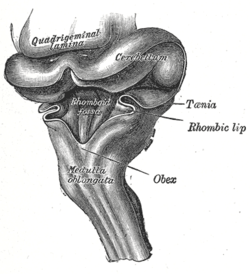Obex
| Obex | |
|---|---|
 Hind-brain of a human embryo of three months—viewed from behind and partly from left side. | |
 Rhomboid fossa. | |
| Details | |
| Identifiers | |
| Latin | Obex |
| NeuroNames | hier-633 |
| NeuroLex ID | Obex |
| TA | A14.1.04.021 |
| FMA | 78490 |
The obex (from the Latin for barrier) is the point in the human brain at which the fourth ventricle narrows to become the central canal of the spinal cord.
The obex occurs in the caudal medulla.
The decussation of sensory fibers happens at this point.
Clinical significance
Lesions at the location can result in obstructive hydrocephalus. The most common lesion at this location is a subependymoma, a benign tumor.[1] Hemangioblastoma has been observed in this location.[2] Neurological surgical intervention in the treatment of syringomyelia or hydromyelia may involve plugging the obex to prevent the transmission of cerebrospinal fluid to the central canal of the spinal cord.Gardner suggested plugging of obex with muscle prevents transmission of CSF wave into central canal.
Additional images
- Fourth ventricle. Posterior view.Deep dissection.
References
- ↑ Hoeffel, C; Boukobza, M; Polivka, M; Lot, G; Guichard, JP; Lafitte, F; Reizine, D; Merland, JJ (Nov–Dec 1995). "MR manifestations of subependymomas.". AJNR. American journal of neuroradiology. 16 (10): 2121–9. PMID 8585504.
- ↑ Pavesi G, Berlucchi S, Feletti A, Opocher G, Scienza R (July 2006). "Hemangioblastoma of the obex mimicking anorexia nervosa". Neurology. 67 (1): 178–9. doi:10.1212/01.wnl.0000223354.86636.ed. PMID 16832109.
